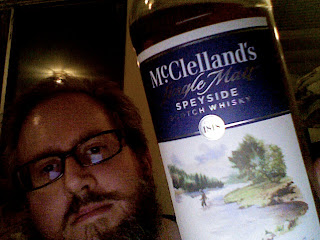
The Balvenie PortWood 21 is one of my absolute favorite scotch whiskies, so I had high hopes for this much less expensive bottling. Unfortunately it did not live up to them; it's certainly not bad, but it just doesn't have a lot of virtues. I noted some cigar magazines and blogs that reviewed it favorably and pointed out that it would go very well with certain cigars. I don't doubt that, but on its own it just isn't exciting.
This whisky is aged in the usual ex-bourbon cask. I couldn't find details on The Balvenie site, but some reviews I came across claim that it spends ten years in the ex-bourbon cask and then another two years in a Oloroso sherry casks. In the glass, it has a slightly dark maple syrup or burnt orange hue. It clings well, with short legs.
To evaluate the nose, I tried for some minutes to snort up anything really complex or subtle, but there wasn't a lot there. There is some oak, possibly a hint of cedar chest, the usual malt and vanilla, a little bit of tobacco smoke, and maybe a very faint lemon peel or fresh fruit note; I was reminded just a little bit, oddly, of blueberries.
In the mouth, there is a big wave of sherry flavors; it is reminiscent of maple, and of tawny port. It's quite sweet, with a long, warm, drying finish. I prefer this one with a little water; it takes down some of the sweetness. But on the whole, this one just isn't impressive enough to really savor. I'm sure I could find a really blockbuster tawny port for the same price that would be much more complex and flavorful. So, this one only gets a 7.0, not because it has any particular vices, but because it lacks virtues.
Skimming some online reviews, I seem to be out of the mainstream in my rating of this one; other reviewers mention "walnuts" and "honeysuckle" which I could be convinced of, various flowers and spices (which I can't find at all). It's enough to make me wonder if we're really tasting the same whisky!



